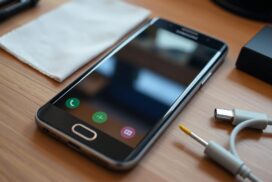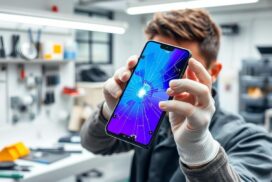Samsung S3 Black Screen? Here’s How to Fix It Quickly and Easily!
A blank screen on your Samsung Galaxy S3 can be frustrating. Whether it’s due to a drop, water damage, or a software glitch, this issue demands quick attention. Before panicking, know that many users resolve it with simple steps.
Common causes include a damaged LCD, loose display connectors, or corrupted software. Experts recommend checking the screen under a bright light or cleaning connectors with isopropyl alcohol. These methods often restore functionality.
If your phone remains unresponsive, deeper troubleshooting may be needed. Stay calm—this guide walks you through proven solutions, from basic resets to advanced repairs. Let’s get your device back to normal.
How to Fix Samsung S3 Black Screen?
Diagnosing display failures requires checking both physical and internal components. A blank screen might stem from a cracked LCD or faulty connections. Follow these steps to pinpoint the issue.
Check for LCD Damage
Shine a flashlight at the screen at an angle. Hairline cracks or dark spots indicate a damaged panel. If the phone vibrates or makes sounds but shows no image, the LCD likely needs replacement.
For DIY repairs, use a Galaxy S3 teardown guide. Handle the Wi-Fi antenna carefully—it’s fragile. Avoid prying tools near the edges to prevent further damage.
Inspect Display Connections
Oxidized or loose connectors often cause display failures. Gently clean the flex cable contacts with 90% isopropyl alcohol. A soft brush removes debris without scratching.
Reseat the cable firmly into its socket. If the screen flickers or turns on intermittently, the connection might be unstable. Test the device after each adjustment.
Quick Fixes to Try First
Before diving into complex repairs, start with these simple solutions. Many display issues stem from temporary glitches or minor hardware faults. These options often restore functionality in under 30 minutes.
Restart Your Device
A forced reboot clears background errors causing the screen to freeze. Press and hold Power + Volume Down for 10 seconds until the device vibrates.
If the buttons don’t respond, remove the battery (if possible). Wait 30 seconds before reinserting it. This resets the phone’s power cycle.
Clean the Display Connector
Corrosion or dust on flex cables disrupts signal transmission. Power off the device and use a soft brush to remove debris from the charging port and connectors.
For stubborn residue, dab a cotton swab in 90% isopropyl alcohol. Gently clean the contacts and reassemble. Test the screen immediately after.
Still no luck? Professional services like Radioshack can diagnose deeper issues efficiently.
Advanced Solutions for Persistent Issues
Persistent display problems often require advanced repair techniques. If your phone shows no signs of life after basic troubleshooting, hardware replacements or diagnostics may be necessary. Below are two proven methods to resolve stubborn screen failures.
Replace the Display
Damaged LCDs often cause unresponsive screens. OEM (original equipment manufacturer) panels ensure compatibility but cost more. Third-party options are cheaper but may lack quality control.
Tools needed:
- Pry tools (plastic spudger)
- Replacement display assembly
- Precision screwdrivers
Risks include damaging the battery or flex cables during disassembly. Work slowly and follow a teardown guide. If unsure, consult a professional.
Test for Board-Level Damage
Motherboard faults can mimic screen failures. Use a multimeter to check power outputs at display connectors. No voltage indicates a deeper problem.
Complex board repairs, like replacing capacitors, require microsoldering skills. For most users, professional services are safer and faster.
| Repair Type | Cost Range | Risk Level |
|---|---|---|
| Display Replacement | $50–$100 | Moderate |
| Board Repair | $200+ | High |
Conclusion
Dealing with an unresponsive phone can be stressful, but these steps simplify the process. Start with basic checks like inspecting the screen under light or cleaning connectors. Often, these quick options solve the problem without costly repairs.
Always back up your content before attempting fixes. For unresolved issues, visit Samsung’s official post or support page. Persistent display failures may need professional diagnosis—don’t hesitate to seek expert help.
If DIY methods fail, tools like Tenorshare ReiBoot offer one-click solutions. Remember, timely action saves time and prevents further damage.
FAQ
Why does my Samsung Galaxy S3 screen stay black?
A black screen can result from software glitches, faulty display connections, or hardware damage like a broken LCD.
Can a simple restart resolve the issue?
Yes, restarting the device often fixes temporary software bugs causing the screen to remain unresponsive.
How do I check for LCD damage?
Look for cracks, discoloration, or flickering. If visible damage exists, the display may need replacement.
What if cleaning the display connector doesn’t help?
If cleaning doesn’t restore functionality, inspect for loose connections or consider professional repair services.
When should I consider replacing the screen?
If basic troubleshooting fails and the display remains blank, a screen replacement is likely necessary.
Could board-level damage cause a black screen?
Yes, internal circuitry issues may prevent the device from powering the display, requiring expert diagnosis.













